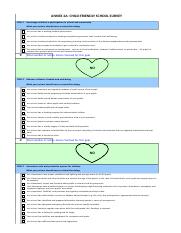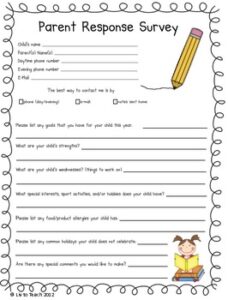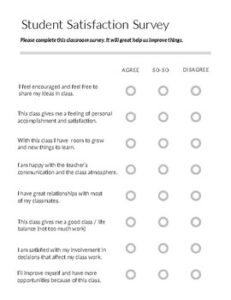Every thriving school community understands the importance of growth and continuous improvement. But how do you pinpoint exactly where to focus your energy for the biggest impact? That’s where a thoughtful school needs assessment comes into play. It’s not just about identifying problems; it’s about uncovering opportunities to enhance learning, support staff, and strengthen the entire educational environment.
Think of it as taking the pulse of your institution, gathering vital insights directly from those who experience it every day: students, teachers, parents, and administrators. A well-designed survey is your most powerful tool in this process, providing a structured way to collect actionable data. Let’s explore how you can leverage such a template to foster a more responsive and effective educational setting for everyone involved.
Why a School Needs Assessment is Crucial for Growth
Undertaking a comprehensive school needs assessment is far more than a bureaucratic exercise; it’s a strategic imperative for any institution committed to excellence. This process allows you to move beyond assumptions and anecdotal evidence, instead relying on concrete data to inform your decisions. It helps in understanding the real challenges and strengths within the school, whether they pertain to academic programs, student support services, professional development for staff, or even the physical learning environment itself. Without this crucial groundwork, initiatives might miss their mark, resources could be misallocated, and opportunities for significant improvement could be overlooked.
Imagine trying to navigate a ship without a map. A needs assessment survey acts as that essential map, highlighting areas that require attention and guiding your school towards targeted interventions. It uncovers gaps between current realities and desired outcomes, providing a clear picture of what needs to change to better serve your students and staff. For instance, you might discover that while academic performance is strong, student mental health support is severely lacking, or that teachers feel overwhelmed by administrative tasks rather than empowered by professional learning opportunities. These are the insights that truly drive meaningful, sustainable change within an educational institution.
Key Areas to Explore with Your Survey
- **Academic Programs and Curriculum:** Are learning objectives being met? Is the curriculum engaging and relevant? Are there specific subjects or teaching methods that need re-evaluation?
- **Student Well-being and Support:** Do students feel safe and supported? Are mental health resources adequate? How effective are current counseling services or anti-bullying initiatives?
- **Teacher Professional Development:** Do educators feel they have the necessary training and resources to excel? Are there specific skills or knowledge areas where more support is needed?
- **School Culture and Climate:** Is the school environment inclusive and positive? Do students and staff feel respected and valued? Are communication channels open and effective?
- **Parental Involvement and Communication:** Do parents feel informed and engaged in their child’s education? Are there barriers to parental participation that need to be addressed?
- **Facilities and Resources:** Are the physical learning spaces conducive to effective teaching and learning? Are technology resources up-to-date and accessible?
By systematically exploring these areas with a school needs assessment survey template, you gather a rich tapestry of perspectives. This collective feedback becomes the foundation for developing strategic plans that are not just theoretical, but deeply rooted in the lived experiences of your school community. It ensures that every new program, every policy adjustment, and every resource allocation is made with a clear understanding of its potential impact on the people it’s designed to serve.
Crafting Your Effective School Needs Assessment Survey Template
Creating an effective survey template requires thoughtful planning, focusing on clarity, relevance, and actionability. It’s not enough to just ask questions; you need to ask the right questions in the right way to elicit honest and comprehensive feedback. Begin by defining your objectives: what specific areas do you hope to improve, and what information do you need to make those improvements? Whether you’re addressing academic performance, student well-being, or professional development, your survey should be designed to gather data that directly informs these goals. Remember, the quality of your insights directly correlates with the quality of your questions.
When designing your survey, consider a mix of question types to capture both quantitative data and qualitative insights. Rating scales (e.g., Likert scales) are excellent for measuring perceptions or satisfaction levels, providing numerical data that can be easily analyzed. Open-ended questions, on the other hand, offer invaluable opportunities for respondents to share detailed thoughts, suggestions, and personal experiences that might not be captured by multiple-choice options. These narratives often provide the context needed to truly understand the numerical data and uncover deeper issues or innovative solutions.
To maximize participation and ensure the integrity of your data, keep your survey concise and user-friendly. A lengthy or confusing survey can lead to respondent fatigue and incomplete submissions. Clearly explain the purpose of the survey and how the collected data will be used, emphasizing the importance of their input. Assure participants of anonymity or confidentiality to encourage candid responses. Providing a clear timeline for completion and choosing an accessible platform for distribution (online or paper-based) will also contribute to a higher response rate and more representative data.
Once the responses are collected, the real work of analysis begins. Look for patterns, recurring themes, and significant discrepancies across different respondent groups (e.g., students versus teachers). This analysis will highlight key areas of strength to celebrate and leverage, as well as critical areas for improvement that demand immediate attention. The insights gained from your school needs assessment survey template are not merely for filing away; they are a powerful mandate for action, driving evidence-based decisions that will shape the future direction and success of your educational institution.
Utilizing a structured approach to needs assessment ensures that your school’s development is guided by genuine understanding and collective input, rather than mere guesswork. By consistently engaging with your community through such surveys, you foster a culture of transparency and collaboration, where every voice contributes to the school’s continuous journey of excellence. This proactive stance not only addresses current challenges but also anticipates future needs, positioning your institution for sustained success.
Embracing this cyclical process of assessment, planning, implementation, and evaluation will empower your school to adapt and flourish. It transforms potential obstacles into opportunities for growth, creating an environment where students, staff, and the wider community feel heard, valued, and actively involved in shaping a brighter educational future for everyone.



